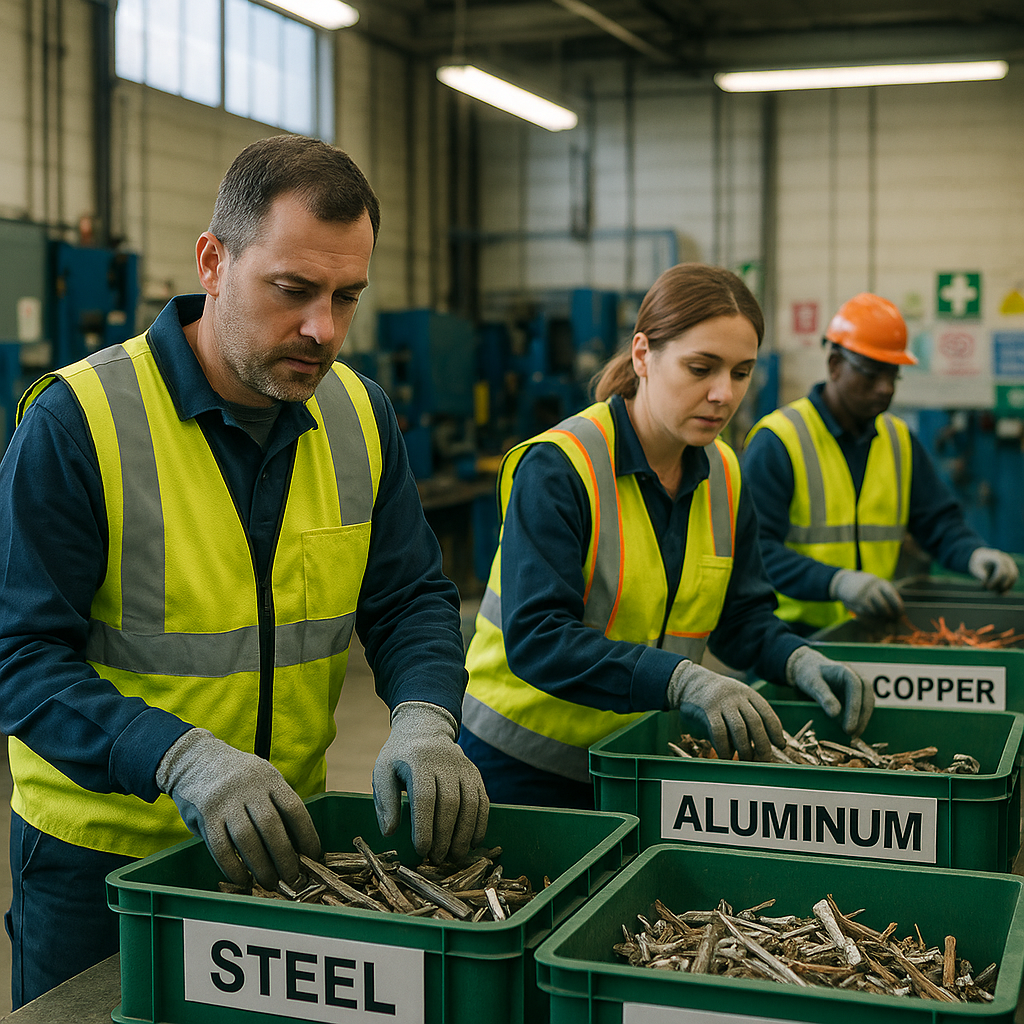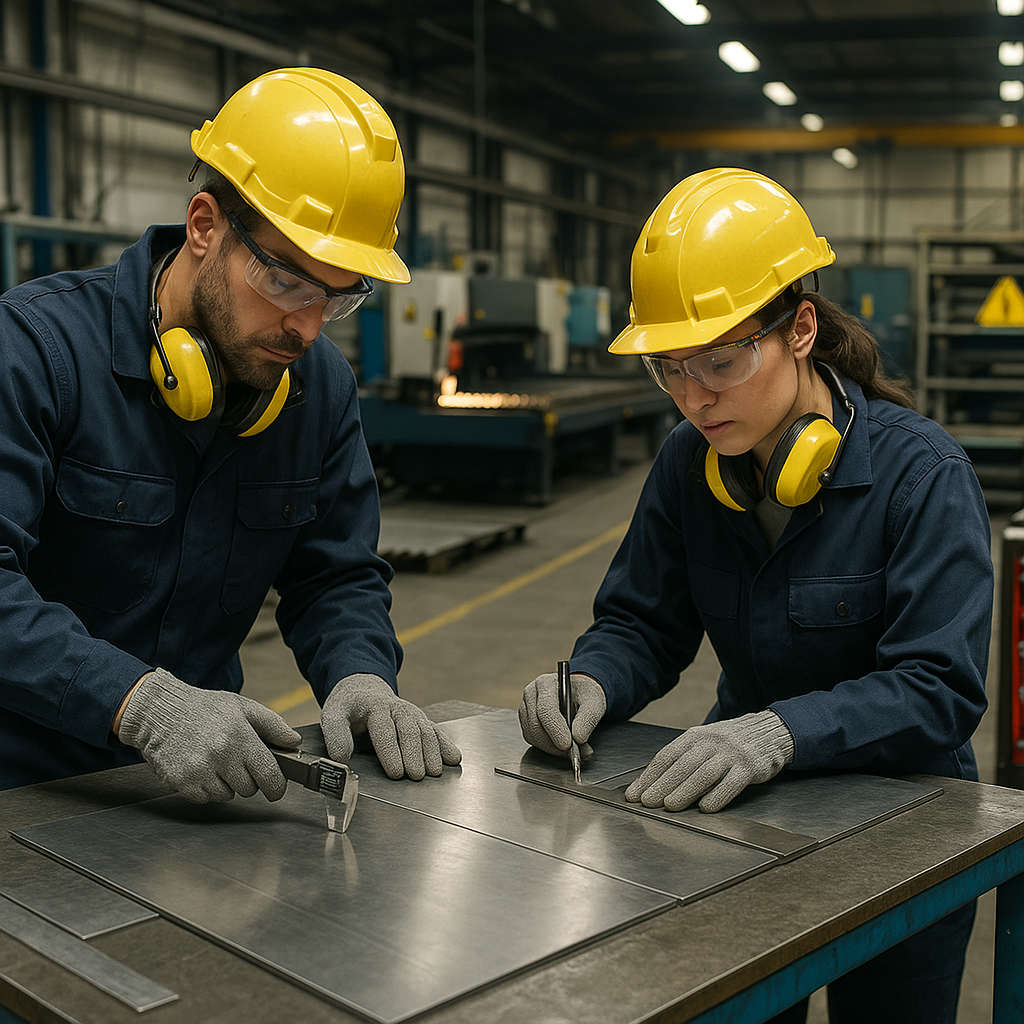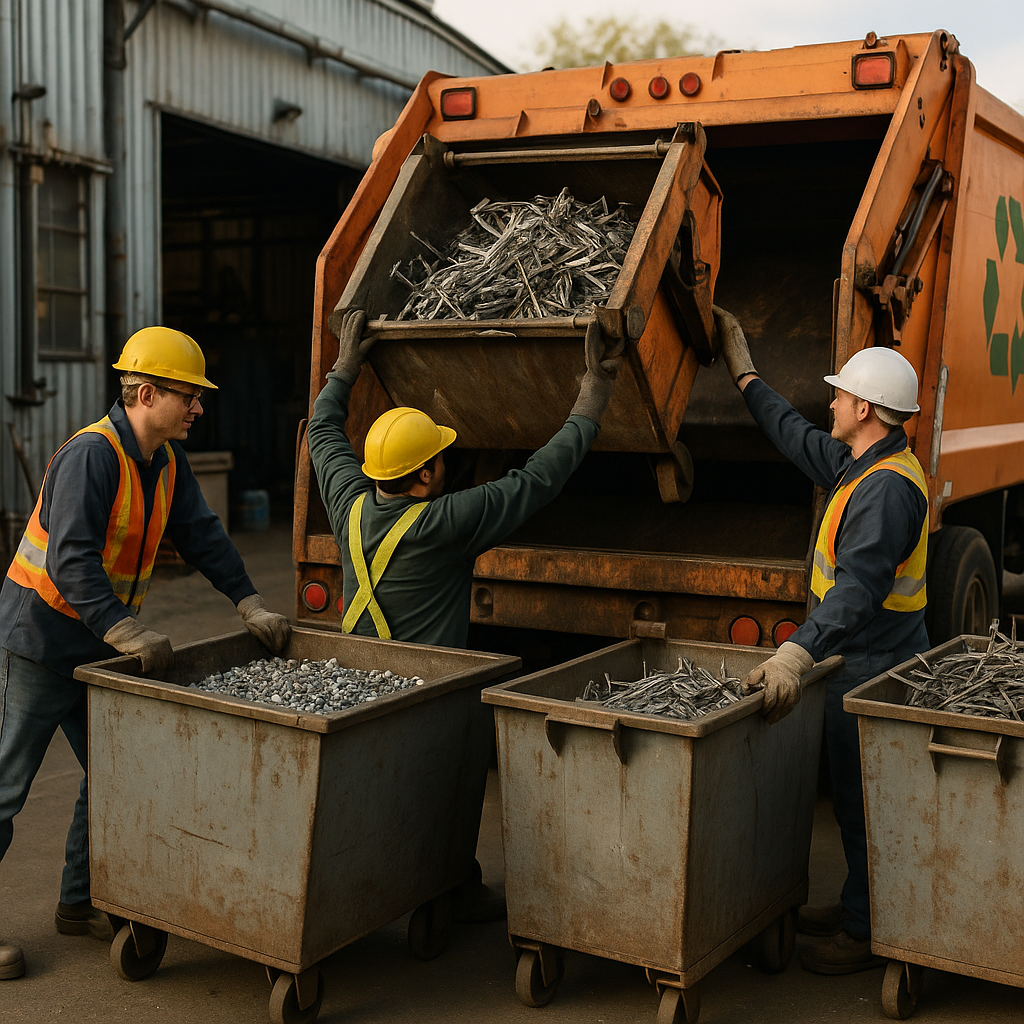5901 Botham Jean Blvd, Dallas, TX 75215
Metal Fabrication Scrap Management: Cut Waste, Boost Recycling ROI
September 8, 2025Metal fabrication scrap management involves systematically collecting, sorting, and recycling waste metals from manufacturing operations. During the cutting, shaping, or machining of metal parts, significant amounts of excess material are produced. These offcuts and residual pieces present both an environmental challenge and a financial opportunity.
Manufacturing facilities generate millions of tons of metal scrap annually. Without proper management, this valuable material can end up in landfills, wasting resources and harming ecosystems. Effective scrap management turns potential waste into a renewable resource stream that supports sustainability goals and provides economic benefits.
The process includes everything from initial collection at production points to final processing at recycling facilities. Modern scrap management integrates with manufacturing workflows, using designated containers for different metal types and implementing efficient transportation systems. This structured approach turns an operational burden into a strategic advantage for forward-thinking industrial operations.
What Are the Key Strategies for Effective Scrap Sorting and Separation?

Successful scrap management starts with systematic sorting and separation. Properly classified metals can increase material recovery rates by 20-40%, significantly enhancing the value of recyclables. Effective sorting transforms potential waste into valuable commodities through strategic organization and handling.
Implement Source Separation Systems
Source separation is crucial for efficient recycling operations. Establish dedicated sorting stations with clearly labeled, color-coded containers to prevent cross-contamination and maintain material value. This setup allows for immediate classification as scrap is generated, rather than sorting mixed materials later.
Strategically placing these stations in high-volume scrap generation areas reduces handling and transportation while promoting consistent sorting practices. Integrating sorting into production workflows in manufacturing facilities creates a seamless waste management system that operators quickly adopt.
- Designated collection areas: Set specific zones for different metal types (aluminum, copper, steel) with clear signage and accessible containers
- Color-coding system: Use distinct colors for different metal categories for quick visual identification
- Systematic organization: Arrange collection points based on material type and waste generation frequency
Utilize Magnetic Separation Technology
The magnetic test is a foundational sorting method in scrap processing, dividing materials into ferrous (iron-containing) and non-ferrous categories. Strong magnets attract ferrous materials like steel and cast iron, while non-ferrous metals such as aluminum, copper, and brass remain unaffected.
Beyond handheld magnets, industrial operations can implement more advanced magnetic separation equipment. Overhead magnetic separators process large volumes of mixed materials continuously, extracting ferrous metals from conveyor lines with minimal human intervention, significantly improving sorting accuracy and reducing labor costs.
- Handheld magnets: Simple tools for initial ferrous/non-ferrous separation
- Suspended magnets: Positioned above conveyor belts to automatically remove ferrous metals
- Eddy current separators: Advanced systems using magnetic fields to sort non-ferrous metals by conductivity
Train Staff on Metal Identification
Knowledgeable workers are key to an effective sorting system. Comprehensive training programs ensure employees can accurately identify metal types based on visual characteristics, weight, and other properties. Regular education sessions help workers recognize subtle differences between similar-looking metals that may have significantly different values.
Effective training combines classroom instruction with hands-on practice using actual scrap samples. Visual aids like posters and reference guides near sorting stations reinforce proper identification techniques. Consider appointing recycling champions to uphold standards and provide ongoing guidance.
- Visual identification guides: Reference materials showing color, texture, and other identifying features of common metals
- Weight and density tests: Techniques for distinguishing metals with similar appearances
- Regular refresher courses: Ongoing education to maintain sorting accuracy and address new materials
Invest in Appropriate Processing Equipment
For operations handling significant scrap volumes, specialized equipment can greatly improve sorting efficiency. Initial investment in processing technology often pays off through increased material recovery and higher scrap values. The right equipment depends on your specific material stream and volume requirements.
Size reduction tools like shears and balers enhance materials’ manageability and increase density for transportation efficiency. For advanced operations, optical sorting systems identify and separate materials based on visual properties at high speeds, especially valuable for processing complex or contaminated scrap.
Comparison of Common Scrap Metal Sorting Technologies
- Shears and balers: Reduce material size and increase density for storage and transport
- Shredders: Break down complex assemblies into easily sortable components
- Optical sorters: Use cameras and sensors to identify different materials based on visual properties
Implement Quality Control Measures
Consistency in sorting quality requires regular monitoring and assessment. Inspection protocols throughout your sorting process help catch contamination early and maintain material purity, protecting both material value and your relationship with recycling partners.
Regular audits of sorted materials highlight training needs and system improvements. For larger operations, consider dedicated quality control personnel to verify proper sorting before materials leave your facility. Document findings and use them to refine sorting procedures continuously.
Proper sorting extends beyond organization. Accurately classified materials command premium prices in recycling markets, while mixed or contaminated loads may suffer value reductions of 30-50% compared to properly sorted materials, often marking the difference between profitable recycling and costly waste disposal.
By applying these strategies, businesses can turn scrap handling from a waste management challenge into a resource recovery opportunity. Strategic sorting maximizes the value of recyclable materials and supports sustainability goals through better resource use and reduced environmental impact.
How Can Companies Reduce Metal Waste in Fabrication Processes?

Metal waste represents a significant cost for fabrication shops—not just in lost material value, but also in disposal expenses and environmental impact. Forward-thinking companies are implementing multiple strategies to minimize scrap and optimize material usage throughout their operations.
Optimize Material Cutting and Layout Planning
One of the most effective ways to reduce metal waste is by thoughtfully planning cutting operations. Companies can significantly decrease scrap by using nesting software that arranges parts to maximize material usage.
This technology analyzes the most efficient way to cut multiple components from a single sheet, reducing drop and edge waste. Some advanced systems can achieve material utilization rates of 80-85%, compared to 60-65% with manual planning.
Fabricators should also consider grouping similar items for cutting. This practice allows for more efficient material usage as parts can be arranged more densely, creating less waste between components.
Use Pre-Cut Materials and Right-Sized Stock
Many fabrication shops have reduced waste by purchasing pre-cut blanks that are closer in size to the final parts. This approach eliminates excess material that would otherwise become scrap.
An aircraft parts manufacturer implemented this strategy and saw immediate benefits. By revising the dimensions of their raw material purchases to better match final product specifications, they significantly reduced high-value nickel and chromium waste.
Right-sizing your material orders is equally important. Instead of defaulting to standard sheet sizes for every job, calculate the optimal starting dimensions. The small additional cost of custom-cut stock is often offset by reduced waste generation.
Invest in Precision Cutting Technologies
Modern cutting technologies have greatly improved material efficiency in metal fabrication. Laser cutting systems, water jets, and CNC machines with high-precision capabilities generate less waste than traditional methods.
These technologies offer tighter tolerances and narrower kerf widths (the width of material removed during cutting), preserving more usable material. Some advanced laser systems can reduce kerf width to less than 0.5mm, saving considerable material over thousands of cuts.
Upgrading older equipment can pay for itself through material savings alone. Many shops report 15-20% reductions in scrap generation after implementing precision cutting technologies.
Implement Lean Manufacturing Principles
Lean manufacturing focuses on eliminating waste in all forms. By adopting these principles, metal fabricators can systematically reduce material waste throughout their operations.
Start by conducting waste audits to identify where and why metal scrap is generated. This data provides the foundation for targeted improvements. Regular audits help track progress and highlight new opportunities for waste reduction.
The 5S methodology (Sort, Set in order, Shine, Standardize, Sustain) creates organized workspaces that reduce errors and material mishandling. When tools and materials have designated locations, workers are less likely to damage materials through improper handling.
Develop Effective Scrap Management Systems
Even with optimal processes, some metal waste is inevitable. Implementing a system to segregate and collect different types of metal scraps ensures maximum recovery value.
Create clearly labeled collection points for different metals throughout the facility. Train employees on proper separation to prevent contamination, which can reduce recycling value.
Many companies establish partnerships with recycling facilities to ensure metal scraps are properly processed. Some fabricators report recovering up to 10% of material costs through effective recycling programs.
Engage Employees in Waste Reduction Efforts
The workforce plays a crucial role in waste reduction success. Employees who understand the value of materials and the importance of waste reduction become active participants in improvement efforts.
Provide regular training on proper material handling and waste reduction techniques. Create channels for employees to suggest improvements based on their firsthand experience with processes.
Some fabricators implement incentive programs that reward teams for waste reduction achievements. These programs foster ownership and continuous improvement in material efficiency.
Use Digital Tools for Performance Tracking
Data-driven approaches help companies monitor and improve material efficiency. Digital tools can track waste generation metrics, recycling rates, and disposal costs to identify opportunities for improvement.
Set clear targets for waste reduction and continuously monitor progress. Visualize this data for employees to raise awareness and motivate them toward achieving goals.
Some fabrication shops use predictive analytics to identify patterns in waste generation, allowing them to address root causes before they result in significant material loss.
What Role Does Recycling Play in Metal Fabrication Scrap Management?

Recycling is essential in effective metal fabrication scrap management, transforming once-unused waste into valuable resources. This practice is crucial as manufacturers strive to reduce costs and minimize their environmental impact.
The effect is significant, with many metal fabrication facilities now recycling over 90% of their metal waste. This high rate is achievable because materials commonly used in fabrication—steel, aluminum, and copper—retain their properties through multiple recycling cycles, making them ideal for reuse.
Resource Conservation Through Metal Recycling
Recycling significantly conserves resources in metal fabrication. The Earth has a limited amount of metal ore, and once extracted, these do not renew.
By recycling scrap metal, fabricators reduce the need for raw ore extraction. This conservation is substantial. Recycling one ton of steel conserves around 2,500 pounds of iron ore, 1,400 pounds of coal, and 120 pounds of limestone.
Additionally, mining’s environmental impact is reduced. Virgin ore extraction causes extensive land disturbance, employs heavy machinery, and requires significant infrastructure, harming habitats and polluting air and water.
Energy Efficiency and Emissions Reduction
The energy savings from metal recycling are remarkable. Processing recycled metals uses significantly less energy than producing new metals from raw ore. Steel recycling saves up to 74% of the energy needed for new production. Aluminum is even more efficient, saving about 95% of the energy required for virgin production.
These savings result in reduced greenhouse gas emissions. The U.S. Environmental Protection Agency notes that recycling a ton of steel cuts emissions by 2.1 metric tons of carbon dioxide equivalent. Overall, the recycling industry reduces emissions by over 186 million metric tons of carbon dioxide annually.
Recycling also conserves water. Producing metals from raw ore requires substantial water for processing and cooling. Recycling reduces water consumption dramatically—recycled metal uses up to 40% less water than traditional processes.
Economic Benefits in the Fabrication Process
Besides environmental benefits, recycling offers substantial economic advantages for metal fabricators. Instead of incurring disposal fees for scrap metal, companies can sell these to recycling facilities. This turns waste management costs into revenue.
Scrap metal value depends on type, quality, and market conditions. High-demand metals like copper, aluminum, brass, and stainless steel usually fetch higher prices. For facilities generating considerable metal waste, savings can be substantial.
Moreover, manufacturing costs decrease with recycled metals. Recycled materials often cost less than virgin ones, reducing production expenses and helping stabilize budgets amid volatile global metals markets.
Proper Handling Through Recycling Partnerships
Successful recycling in fabrication facilities requires proper handling and procedures. Many now partner with specialized recycling companies to ensure correct scrap processing.
These partnerships typically involve designated collection areas, tracking systems, and employee training in proper sorting techniques. Proper sorting at the source maintains higher scrap value and reduces processing needs.
Professional recyclers also help address potentially hazardous materials, such as lead and mercury. Processed appropriately, these toxins can be safely disposed of, preventing environmental contamination.
To maximize recycling benefits, metal fabricators should implement comprehensive scrap management systems. These systems not only enhance environmental performance but also offer measurable economic advantages by reducing waste costs and creating new revenue opportunities.
How to Implement an Effective Scrap Management Plan in Metal Fabrication
Conduct a Comprehensive Waste Stream Audit
The foundation of any effective scrap management plan is understanding the waste you’re generating. A thorough waste stream audit involves analyzing all scrap metal produced during fabrication processes to identify types, quantities, and potential value.
Start by collecting data from every production area over a set period. Document metal types, weights, and the processes generating the most scrap. This baseline information reveals opportunities for immediate improvement and helps establish realistic goals.
During the audit, identify which metals have the highest recovery value. Aluminum, copper, and stainless steel typically command premium prices in recycling markets, making them priorities for careful segregation and handling.
Establish Clear Reduction and Recycling Goals
With audit data in hand, set specific, measurable targets for your scrap management program. Goals might include reducing overall scrap generation by a certain percentage, increasing recycling rates for specific metals, or achieving cost savings through improved material utilization.
Make goals challenging yet achievable. For example, aim to reduce stainless steel scrap by 15% within six months or increase the recovery rate of aluminum scrap to 95% by year-end. These concrete targets give your team direction and provide metrics to measure success.
Develop both short-term and long-term objectives. Quick wins build momentum while longer-range goals drive sustained improvement in your scrap management practices.
Invest in Proper Storage and Equipment Solutions
Effective scrap management requires appropriate infrastructure. Use clearly labeled, dedicated containers for different metal types to prevent cross-contamination. Storage solutions should protect valuable scrap from weather damage and contamination that could reduce its value.
Consider equipment investments that enhance scrap handling efficiency. Balers, compactors, and shredders can reduce volume and prepare materials for recycling. Magnetic separators effectively extract ferrous metals from mixed waste streams.
Locate storage areas strategically throughout the facility, making proper disposal convenient for workers. The easier it is to follow correct procedures, the higher compliance you’ll achieve.
Develop and Implement Employee Training Programs
Even the best-designed system fails without proper employee participation. Develop comprehensive training programs that help workers understand the importance of scrap management and their role in its success.
Training should cover basic metal identification, proper sorting techniques, and the economic and environmental benefits of recycling. Make the content relevant by showing how improved scrap management directly benefits the company and employees.
Use multiple training approaches to accommodate different learning styles. Hands-on demonstrations, visual aids, and regular refresher sessions reinforce proper practices. Consider designating “scrap champions” in each department to model correct procedures and answer questions.
Establish Strategic Recycling Partnerships
Selecting the right recycling partner is crucial for maximizing the value of your scrap materials. Look for recyclers experienced in metal fabrication waste who offer transparent pricing and reliable service.
A good recycling partner provides insights on market trends and helps optimize your program. They should offer regular pickup schedules tailored to your production volume and storage capacity. Many recyclers also provide containers and handling equipment as part of their service.
Consider negotiating longer-term agreements that provide price stability while allowing flexibility to capitalize on market upswings. Regular communication with your recycler helps ensure you’re getting competitive rates for your materials.
Implement Monitoring and Reporting Systems
What gets measured gets managed. Establish systems to track key metrics like scrap generation rates, recycling percentages, and financial returns. This data helps identify trends, measure progress toward goals, and highlight areas needing improvement.
Regular reporting keeps scrap management visible as a priority. Share results with management and employees to maintain focus and celebrate successes. Use visual management tools like dashboards or charts in production areas to provide immediate feedback on performance.
Schedule regular reviews of your scrap management program. These assessments should examine what’s working well, what challenges exist, and what adjustments might improve results. This cycle of continuous improvement drives ongoing optimization of your scrap handling processes.
Stay Updated on Market Prices and Industry Trends
Scrap metal markets fluctuate based on global supply and demand factors. Staying informed about current prices and trends helps you make strategic decisions about when to sell certain materials or when to hold inventory.
Develop relationships with industry contacts and subscribe to reliable market information sources. Many recyclers provide regular market updates to their customers. Understanding price trends helps you forecast revenue from scrap sales more accurately.
Watch for emerging technologies and practices in scrap management. Innovations in separation, processing, and tracking continue to evolve, potentially offering new ways to extract more value from your scrap materials.
Conclusion: The Future of Metal Fabrication Scrap Management

Effective management of metal fabrication scrap is essential for manufacturing facilities that aim to balance environmental responsibility with economic growth. Companies implementing comprehensive strategies for sorting, reduction, and recycling gain a competitive edge. These strategies offer more than just cost savings; they enhance regulatory compliance, resource conservation, and brand reputation.
The metal fabrication industry is shifting toward more sustainable practices. Technologies like AI-powered sorting systems, digital twin modeling, and automated scrap collection are transforming waste management in facilities. Forward-thinking manufacturers are using these innovations to create closed-loop systems that enhance material recovery and minimize environmental impact.
As environmental regulations tighten and customer expectations for sustainability rise, efficient scrap management becomes increasingly important. Companies investing in these systems will be better equipped to meet future market demands and contribute to a more circular economy. For assistance with implementing effective metal scrap management solutions, contact Okon Recycling at 214-717-4083.
